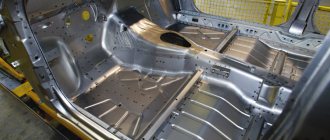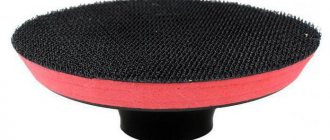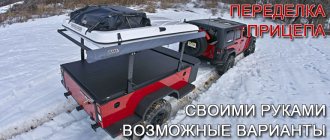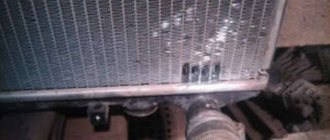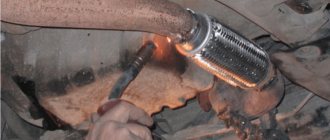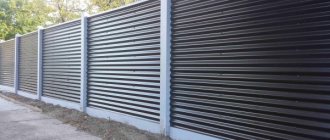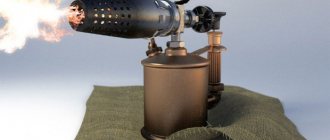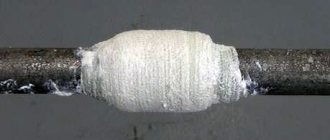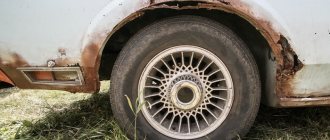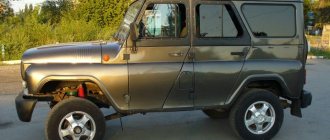How to properly weld the underbody of a car with your own hands
For a car with high mileage, corrosion of the bottom is a common thing. Mechanical damage, high humidity, and deicing agents destroy iron over time. The metal turns to dust. Driving such a car is dangerous, the car needs repairs. It is not profitable to contact a service station; the technicians may overcharge you. Having a welding machine, it is easy to weld the underbody of a car in the garage. It is important to take into account some nuances and adhere to technology. It is more convenient to carry out the work together; a partner will help fix the patch before tackling.
Tools and materials
To weld the bottom, in addition to welding equipment, you will need consumables. When choosing which metal to cook with, you need to consider two points:
The patches are made of metal with a thickness of 1 to 2 mm - these are the optimal parameters.
What you will need when working:
The bottom is viewed on an overpass or in an inspection hole in good lighting. The metal is tapped with a hammer to test its strength. A lift will be needed to provide access to the damaged areas.
You will need a rust converter, soundproofing coatings; anti-corrosion compounds; primer for metal; solvent or other degreasing compound.
Unexpected expenses
It is necessary to provide for the purchase of spare parts. Their necessity is determined after inspecting the car. During repair work, dilapidated elements of the machine are replaced:
Sometimes other elements of the machine require replacement. It is better not to purchase spare parts for future use; they may not be needed.
HOW TO WELD A CAR BODY YOURSELF
Welding a car body yourself is not an easy task and requires certain skills when working with welding devices; you must be able to determine the place that needs to be patched. In this case, it is necessary to examine the body with special care and analyze the metal in the place where corrosion occurred. After the inspection, you can determine the type of repair and divide it into local and complete.
A complete repair means the largest part of the car body, and a local repair means the elimination of minor corrosion in a separate place. If the car owner has already carried out welding work more than once, it will not be difficult for him to make repairs. And if the welder is a beginner, then it is recommended to start from a local place.
If rotting has begun in a place that is not visible to the eye, for example, on the bottom, then to eliminate the hole you can use any metal as a patch, but taking into account the quality and thickness. In cases where corrosion has occurred in a visible place, it is recommended to use the same metal that was used in the manufacture of the body. And it is important to try to make the seam almost invisible.
If corrosion has affected a small area, welding work can be avoided.
In this case, you can use a special mixture that includes fiberglass and epoxy resin. With this composition you can achieve the same effect as when welding, and the appearance of such a patch will be much more aesthetically pleasing.
For better reliability, it is recommended to glue welded joints in places of cracks.
Preparatory work
When the iron is rotten in several places, it is easier to digest the entire bottom. In some cases, replacement is more profitable than installing a large number of metal patches. Repairing the underbody of a car with your own hands begins with the preparatory stage. Areas with large defects are cut out, small ones - just cleaned of rust. When it is difficult to reach with a grinding wheel mounted on an angle grinder, turn on gas welding.
The seam areas on the machine and patches are coated with a rust converter, then cleaned to a shine. After this it is degreased. The patches are adjusted to the bottom configuration using heat, the metal is easier to deform, or special bending devices.
Body finishing
After completion of electric welding, perform the following steps:
- Clean welded joints from slag. This reduces the likelihood of oxidation of metal elements. To treat hidden places, use an iron brush. Open areas are sanded with a grinder and a special wheel. A sander with a burr is suitable for cleaning hard-to-reach areas.
- Degrease treated surfaces by wiping them with solvent. After this, the parts are coated with an anti-corrosion agent or acid primer. The best option is epoxy putty, which protects surfaces from moisture and air. It aligns the welded joint. The composition is applied in a thin layer and left for a day. You cannot dry the putty with a hairdryer.
- Re-treat the surfaces with sandpaper. Apply the second and third layers of putty. Prepare the body for painting.
We recommend reading: Welding a sauna stove yourself at home
Seam sealant for cars is used to protect connections in hidden places. It is leveled and painted. The sealant is applied using a pneumatic sprayer with a plastic nozzle.
Welding process
Before hot work, for safety reasons, the gas tank must be dismantled. The patch is first grabbed at 3-4 points, then completely scalded. Small defects are filled with short seams up to 3 cm long. Welding the bottom is difficult to do alone. When a partner holds the patch, the repair speeds up.
It is important that the patch fits tightly to the repair site. Gaps increase the risk of corrosion damage. The seams are hammered for strength. In good lighting, all repair areas are checked. If necessary, boil the connection again. Only after inspection do they begin to clean the seam rollers.
How to treat the bottom after welding
Before applying corrosion protection, primers are first used. They are applied to clean surfaces according to the instructions and dried. The primer ensures reliable adhesion of steel to anti-corrosion. Manufacturers offer various compositions:
After welding the car body parts, the sound insulation must be restored. To cover the bottom, Prim anti-noise with micro-rubber crumbs is convenient. The composition is diluted with water and simultaneously acts as noise insulation and anticorrosive.
Useful tips
To repair the underbody of a car with your own hands, experts recommend using semi-automatic machines. The additive is supplied at a fixed speed, the burner provides uniform heating. The seam is of high quality and even. When working with electrodes, an inverter with additional functions that support constant operation is convenient. They reduce the risk of electrode sticking.
Before cutting a sheet of metal, the exact dimensions of the defect zone are determined. The patch must be suitable in size and adhere to the geometry. To deform, the sheet is not heated for a long time - the strength characteristics of the alloys decrease and they become friable. Movements of the hand with the holder or attachment should be uniform, without jerking. Large sections are connected with a continuous seam, leaving gaps of up to 3 cm. Such connections better withstand dynamic loads and increase the strength parameters of the body. Such connections require a durable insulating coating. Mastic prevents moisture from getting into microscopic gaps.
Protective fluxes are used to work with galvanized iron; they preserve the coating from boiling and burning. Knowing the intricacies of the process, making the connection is not difficult. The main thing is to take your time and carefully prepare the surfaces before work. Anti-corrosion work should not be neglected. The bottom is subjected to heavy chemical load during operation. Protective compounds are applied in an even layer.
Source
Kaliostr0 › Blog › What a beginner needs to start welding work on a body
ATTENTION! This note outlines one of the many options available to beginners when starting welding work on a car body. This option is based on the author’s experience and is intended to demonstrate the solution to two main problems facing a beginner: 1) what equipment and equipment to purchase in order to complete the work and not spend too much money. 2) how to perform welding work.
SPECIAL ATTENTION! This note describes what the author himself uses (that is, I personally). Anyone who tries to accuse me of advertising - go... past!
Part 1. Equipment and equipment.
The minimum set of equipment will be: 1) A grinder with a circle diameter of 115 mm and a power of 300 - 450 Watt. It’s not worth taking a larger one, because... It will not be convenient to make cuts in local areas of the body. The circles for it have a thickness of 1 (for most panels) and 2 mm (for spars). Round brush. Cleaning disk (shaped) 5-6 mm thick (for grinding off excess welding. 2) Attachment for an angle grinder such as a belt grinder (file) for cleaning/grinding in narrow places
Tags: patches, welding
Comments 42
Just use the old bodywork for patches. it is properly primed and the primer there is factory epoxy or cataphoresis. (well, this applies to Japanese cars of the 80s-90s) in terms of corrosion resistance, it is better than new metal from a metal depot that is made from recycled materials
take it from the refrigerators)))))
take cold rolled one and the same thickness as the machine. I cooked mine with 1.2mm HK - it’s all made from it
It’s good to use a 1mm xk sheet. There’s no point in anything else. Occasionally you need a 2mm sheet. Quite often, it makes sense, instead of one 2mm sheet, to use 1mm+1mm, which are held on points; for this, holes are made in one sheet and welded through them, after covering with primer. You can also lubricate between the sheets with a push-type lubricant. lard or analogues, although it shoots and smokes, but inside the fatty layer remains almost everywhere
good to use for patches, especially power and internal parts. stainless steel, it cooks very well and softly with black steel using a conventional semi-automatic +co2
Repair tools and materials
In half of the cases, the need for a full underbody repair is discovered by technicians at a service station during routine vehicle diagnostics. When the car is lifted onto an overpass, it is easier for a mechanic to see corrosion plaques on the metal, dents from impacts, etc. The cost of repairs depends on the degree of damage; in a workshop this is a justifiably high price of 10,000 rubles. only for overcooking the thresholds.
But in the case of a body, the degree of damage to the metal may be excessive and it will not be necessary to repair the bottom with patches, but to completely or partially replace the load-bearing elements. Many drivers choose garage repairs; it is 10-15 times cheaper; if the technician has skills in gas or electric welding, the cost of the work is minimal.
Before welding the underbody of a car with your own hands, you need to prepare the following tools and materials:
Equipment and tools that will be required for repairs:
During the work, you may need a degreaser, a spot welding machine for tack, and R-80 sandpaper.
HOW TO CORRECTLY COOK A MACHINE WITH ELECTRODES
It's no secret that the body is the most important element of any car, which requires special attention and care, diagnostics and repair. Welding is one of the components. Often, car enthusiasts can do the welding themselves. But before you cook a car with electrodes, you need to acquire special equipment.
In most cases, the car begins to rot from the lower part of the body. But the machines are operated under different conditions, and the problems arise almost the same. Most often, lesions occur in those places that are most in contact with a humid environment:
The thresholds and the inner surface of the wings deteriorate first, since when driving in rainy weather and snow, dirt and moisture are deposited in these places. As for the front part, it begins to rot under the floors. But in the trunk, moisture accumulates in the space for the spare wheel, since few people try to wipe it off after replacing the spare tire.
This raises the question of what to do if the car requires body repair. You just need to weld the failed areas.
What metal to use to weld the underbody of a car, its thickness
The thickness of the metal for over-welding the floor must be at least 2 mm. Technologists recommend using sheet steel, material st2, to save money. Stainless steel or alloy steel can be used if the repair is done by a professional welder. In 70% of cases, non-professionals experience welding joints bursting due to engine vibration when moving.
Stainless steel can be used as small patches for partial bottom replacements. Aluminum sheets are used to strengthen the bottom of the car without welding. Aluminum oxidizes the metal, causing rapid corrosion. If aluminum is used to strengthen the bottom, it is necessary to avoid its contact with the metal of the body through the use of rubber bushings or gaskets.
Cold methods of sealing holes in metal
There are two ways to repair holes in the underbody of a car without using hot work.
- Using composite materials - various types of polymer resins in combination with a reinforcing filler and a curing reaction accelerator. With high-quality surface treatment, in addition to restoring mechanical strength, they play the role of inhibitors - retarders of chemical and electrochemical corrosion reactions;
- Installing sheet material patches onto rivets.
Repairing large-scale damage
In this case, you will have to take care to restore mechanical strength. If the hole is on a flat area, then there is no point in messing around with epoxy and fiberglass.
A truly durable composite material is obtained only with absolutely precise adherence to technology - mixing proportions, drying mode and much more. Use ready-made material of this kind, for example, textolite. Having a thickness of 3 mm, it is not inferior in strength to sheet iron. The plate can only be installed with epoxy glue, but it is better to use a combined connection using rivets. The latter should be made of aluminum, then they will play the role of cathodic protection.
Patches on the bottom of the car
Long holes at the joints with power elements are eliminated with patches made of sheet iron or aluminum. They need to be bent according to the shape of the joint so that the width of the contact zone with the still living material is at least 2 cm. They are installed on aluminum rivets; the use of an epoxy compound would be useful. Especially if sheet metal is used. After all, you cannot know exactly its composition and in which direction electrochemical corrosion will go - whether it will destroy the patch or the body. The polymer resin will act as an inhibitor.
The final sealing of cracks and holes is carried out using, for example, the Novol Plus 710 kit. In addition to the epoxy filler and hardener, it includes a piece of fiberglass.
Fixing pinholes
If the source of through corrosion has a diameter of no more than 1 centimeter, it can simply be covered with a two-component polymer composition. Poxipol glue or a cold welding kit similar to plasticine gives good results.
A small hole makes it possible to use so-called cathodic electrochemical protection. Find an aluminum rod, make a rivet out of it and fill the hole with it. Within a radius of 20 cm from it, corrosion will stop. True, the rivet will gradually collapse on its own. But this may take five years.
Stages of work
Only in the video tutorial does it take a short period of time to independently overcook the bottom. In fact, repair work takes from 3 days and goes through the following stages:
Dismantling the interior involves disconnecting most of the electrical cables that go to power windows, batteries, sensors, also removing seats, carpet, sound insulation, dismantling doors, installing the car on an overpass or lift. Be sure to drain the fuel from the tank.
Some drivers turn the car on its side if the bottom and sills are partially overcooked.
After dismantling the attachments and panels, it is necessary to check the quality of the metal on the sills and wheel arches. These elements are the first to be damaged by corrosion.
Operating principle and theory of semi-automatic electric welding
Welding with a semi-automatic inverter using carbon dioxide is today the most common type for self-repair of the bottom. Using gas welding is quite problematic, since it is difficult to make a high-quality seam.
The carbon dioxide semi-automatic machine allows you to weld metal with a thickness of 0.8 to 6 mm, has compact dimensions, and is convenient for welding difficult areas. The machine uses carbon dioxide; it enters the welding zone under pressure and displaces air, preventing oxidation of the metal, which does not burn, but melts. The welded sections are connected, forming an even, narrow seam.
Preparation of the welding machine takes place in the following stages:
It is recommended to use technical carbon dioxide for welding; the chemical has less water vapor than food-grade carbon dioxide.
What seam to weld the underbody of a car
There are several techniques for cooking the bottom of a car. Professional tinsmiths recommend using step welding, welding in stitches: 2 cm of welded metal, 5 cm gap. This type of welding increases the rigidity of the body and enhances the tensile safety of the structure. During vibration during movement, the bottom does not deform, as with welding with a continuous seam, and does not tear, as with spot welding.
If the front floor elements of a car are attached to a cross beam, the attachment points must be welded.
After welding, galvanized body parts lose their protection; treatment with anti-corrosion compounds and painting with body sealant is mandatory.
If you need to weld car sills, then electric welding is used. If it is necessary to extract metal after a dent or weld a small patch, spot welding is used with a spotter.
Car welding instructions
The procedure for restoring the body or other parts of the car depends on the chosen method.
Using the Electrode
This method is used in the absence of high requirements for the aesthetic qualities of the seam . Choosing the right electrode for the type of metal helps ensure a strong connection. It is recommended to use inverter equipment that supports a stable arc. The reliability of the weld depends little on the experience of the welder.
To reduce the likelihood of joint deformation, welding work is performed in the following sequence:
- Create potholders.
- Apply short stitches in 5 cm increments.
- Weld the part with a continuous seam.
After each step, take a short break to allow the metal to cool. Welding thick automotive parts can take 3-5 hours. Forced cooling is prohibited: it greatly reduces the strength of the connection.
Semi-automatic device
To weld with such a unit, you will need copper-plated wire with a diameter of 1 mm, coarse sandpaper, a gearbox, and carbon dioxide.
We recommend reading: How to make sliding gates yourself
The work is carried out as follows:
- The edges treated with abrasive material are installed as close to each other as possible. For fixation, self-tapping screws, bolts, and clamps are used.
- Set the required current strength and supply speed of the consumable material using the regulators located on the device body.
- The gas cylinder is equipped with a reducer and a hose. Unscrew the nozzle and remove the tip from the burner.
- Install a coil of wire into the apparatus. The free end is inserted into the feed mechanism. Place the tip on the wire and return the nozzle to its place.
- The polarity is set: the holder is connected to the plus, the burner to the minus. The opposite option is installed when using wire that is not coated with copper.
- Connect the unit to the electrical network. The burner is brought to the area to be treated. Press the button to start the supply of gas and filler material. To form a long seam, you need to weld 3-4 points. Next, stitches 2-4 cm long are made.
- Wait for the metal to cool, weld the distances between the tacks.
SAIPA-165
Inverter Features
The popularity of such devices is explained by their compact size, low power consumption, the use of new current conversion technologies, and an expanded range of modes. The unit can operate in a wide range of input voltages. The arc is excited quickly and burns stably.
Many people starting work for the first time wonder whether it is possible to cook a car with an inverter. The process is not much different from standard welding, but the seam is of lower quality - uneven, thick.
The metal overheats, which can cause it to become deformed. Inverter technology is used to repair hidden places, such as the bottom.
The final stages when working with the bottom
After welding the car body with a semi-automatic machine, you will need to clean the seams with a grinder, treat them with anticorrosive, and prime them. After welding, the main vulnerable spots remain the weld seams, since the process of digesting the metal has damaged its structure. It is necessary to process the seam both from the outside of the bottom and from the inside.
If an aluminum patch is welded to a metal body, then it is necessary to apply anticorrosive in two layers and regularly check and tap the seam. Aluminum oxidizes and upon contact with sheet metal, pockets of corrosion form on steel sheets. Craftsmen do not recommend welding aluminum to the tin bottom of the machine; it is better to use bolt mounting with a safety gasket.
Occupational health and safety during welding
The main traumatic factors of welding:
- Heat. Burns can be caused by the arc itself, the hot metal of the parts being welded, the electrode holder or the torch.
- Light radiation that affects the retina and cornea of the eyes.
Do not look at the arc when close to the welding site, even briefly. When working independently, the use of a mask is mandatory.
The burn causes pain, a feeling of “sand” under the eyelids. Eye drops will help, and folk remedies include applying slices of raw potatoes to the eyes. Be sure to consult an ophthalmologist.
- Electricity.
Before you start welding for the first time, carefully study the rules for safe operation of the equipment.
Wear thick, long-sleeved clothing that protects against metal splashes, and gloves made of split leather or thick fabric. Put a hat or balaclava on your head.
How to save money
The only way to save on auto body work is to do it yourself. You cannot skimp on either anti-corrosion treatment material or metal. If you are not an experienced welder and doubt the quality of the repair, it will be cheaper to invite a specialist than to redo broken seams a year later.
The cost of underbody repair in a specialized car service starts from 22-25,000 rubles. And this price is justified. Included in the price:
Drivers prefer to do their own repairs because the stereotype is that service stations increase prices and invent defects that do not exist. To avoid deception, it is recommended to tap the bottom of the car yourself on an overpass; if there is minor damage that does not require complete overcooking of the bottom, then opt for independent repairs.
Welding current adjustment
For novice welders who have not worked with thin sheets smaller than 1 mm, it is advisable to practice not on the working surfaces of a car, but to conduct experimental welding of unnecessary thin pieces.
It is necessary to adhere to safety precautions when welding work on a car:
- there is no need to take galvanized specimens as experimental sheets, since the fumes will be poisonous;
- Work cannot be carried out in a strong draft or wind, as this will blow gas out of the welding zone, which will reduce the quality of the work or make it completely impossible.
The amount of welding current is directly dependent on the thickness of the metal. For sheets of small thickness, you will need to set the current in the range of 40-60 A.
Most current regulators on semi-automatic machines do not have absolute graduations, but relative ones. Therefore, the exact current indicator will need to be checked according to the instructions.
The correctness of the selected current will indicate the quality of the weld. Different voltages in the electrical network affect the output parameters of the device. Therefore, setting up the device is carried out to a large extent by experimentally selecting the positions of the adjustment knobs.

